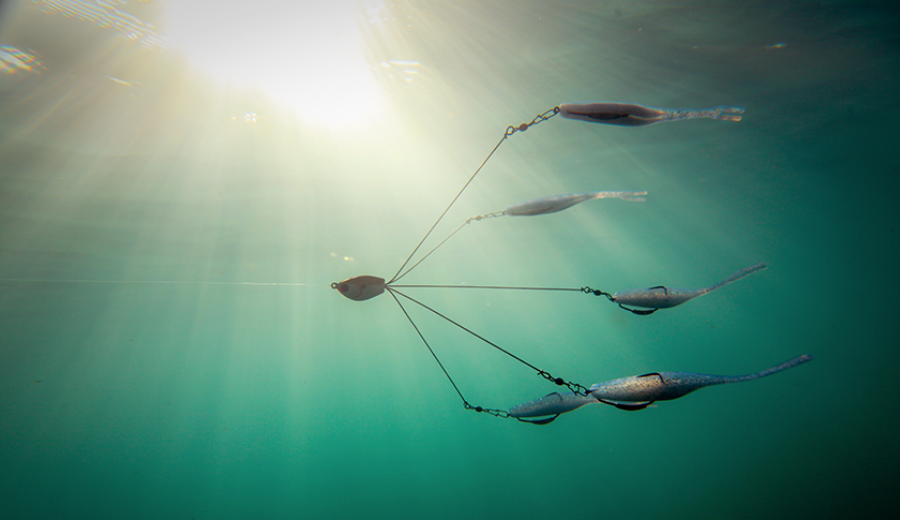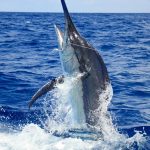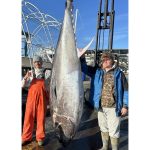Article Courtesy: floridasportfishing.com | Originally Published: 2/5/2019 | Click here for original article
Strength in Numbers
Ever since anglers began presenting artificial lures, the goal has been to fish the most lifelike offerings possible. Lure manufacturers continue to innovate and perfect fake baits to precisely mimic the prey that our target species actively seek in their natural surroundings. However, in waters around the world game fish feed on schooling prey, and it wasn’t until the introduction of the umbrella rig that anglers could effectively mimic a naturally occurring school of baitfish.
After taking the freshwater industry by storm not long ago, the umbrella rig is now known by many as the Alabama Rig and has become a regular in the tackle boxes of bucketmouth enthusiasts everywhere. In 2011, Andy Poss of Muscle Shoals, Alabama, began selling his Alabama Rig after roughly two years of development, designed specifically for targeting largemouth bass.
Though this aptly named rig was new to bass fishermen, the same concept had already been in use for many years in the waters off the northeast coast of the United States to entice striped bass and bluefish. It’s an extremely effective approach and still widely used today. Not to discredit Poss or his hard work and innovation in designing this wildly effective lunker magnet, but the general idea has been around for longer than people may think.
When small forage fish feel threatened their instinctual behavior and sole defense mechanism is to gather in a schooling formation. There truly is strength in numbers. Yet even with dazzling maneuvers to avoid predation, herring, pilchard and sardines don’t stand much of a chance against ravenous jack crevalle, bluefish, Spanish mackerel and more.
While avoided by many and not yet fully accepted by Florida fishermen, umbrella rigs are undeniably effective. These wild-looking artificial contraptions aren’t ideal for every application, but the basic configuration remains the same wherever it is used—a stainless steel wire frame with several artificial baits attached.
Anglers across wide-ranging venues have experimented with a variety of artificial lure size and color combinations for different applications. You can essentially attach any sub-surface lure that matches local forage species. Though these arrangements look like smaller versions of hookless dredge teasers used in offshore venues, umbrella rigs in Florida are best applied inshore and near-shore.
Saltwater umbrella rigs are effective in casting situations, though the wire frame and collection of trailing lures requires a stout rod and heavy main line. Even with the right equipment, casting something that heavy for an extended period of time takes total commitment and is very tiring. Luckily, umbrella rigs are also effective in trolling scenarios.
Whether casting or trolling, the best approach is to slow things down. Though many lures are effective when retrieved quickly with sporadic movement, a slow roll presentation is best when attempting to mimic schooling baitfish. The perception of multiple forage fish slowly swimming by is irresistible to predators and highly effective in triggering aggression from less active fish. This is especially true during the winter when water temps are down and feeding patterns change with each passing frontal boundary.
One of the aspects that can steer anglers away from trying umbrella rigs is the potential for creating a tangled mess among the multiple hooks deployed in such close proximity. There is merit to this argument, as casting in windy conditions can be problematic. While most use ?- to ½-oz. jigheads rigged with soft plastic grubs, worms and swimbaits, weighted worm hooks provide the same appeal but with a presentation that eliminates snag points.
The Alabama rig exploded in popularity in October 2011 when Paul Elias, a former Bassmaster Classic champion, dominated the field at a FLW Tour event by landing four consecutive five-bass daily tournament limits to finish with an untouchable 102.5-pound aggregate. FLW, B.A.S.S. and many other professional organizations have since banned the multi-bait presentation, with several states throughout the country also cracking down on the use of multi-hook rigs. While the lure is impressively effective at enticing suspended bass, as of press date there are several states that limit the amount of artificial lures—with or without hooks—anglers are permitted to fish from a single rod and reel outfit.
Still, the use of five-hook umbrella rigs in Florida’s fresh and saltwater venues remains permissible by the FWC even though the general public hasn’t readily accepted the approach. Though some claim it is unethical and non-sporting, don’t overlook this method’s impressive potential in our inshore and near-shore waters this coming season.






